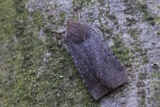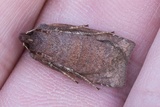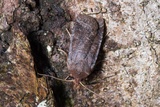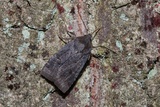Conistra ligula (Esper, 1791) Species
Last modified: Nov. 19, 2025, 4:23 p.m.
A very rare species in the northern part of Belgium. Uncommon but more frequently observed in the south.
The dark unicolorous forms are predominant.
This species is considered Near Threatened according to the IUCN Red List category for Flanders 2023.
Details
- Classification
- Family: Noctuidae > Subfamily: Xyleninae > Tribus: Xylenini > Genus: Conistra > Subgenus: Conistra > Species: Conistra ligula
- Vernacular names
- Donkere winteruil (NL), Dark Chestnut (EN), L'Orrhodie ligulée (FR), Gebüsch-Wintereule (DE)
- First mention in Belgium
- Lambillion L.-J. 1904b. Varia — Revue mensuelle de la Société entomologique namuroise 4: 15–16, 35–36, 44, 52. On page 16.
- Status
-
Native
Distribution
Imago
Wingspan 30–38.
A good feature to distinguish Conistra ligula is the color of the cilia on the underwing, especially the hindwing. This is always grey while reddish/brown in Conistra vaccinii.
Bionomics
The larva lives at first on the catkins and leaves of the host plant.
Hibernates initially as an adult. They mate in December or January and eggs are laid in January or February.
Males die around December or January, while females live till February or even till early April.
They come to light and are more frequently recorded at sugar and on flowers of Hedera.
Flight periods
The adults fly from early October till December and reappear after hibernation sometimes as early as January, but usually from February till early April in smaller numbers.
Observed on
- Host plant (species):
- Prunus spinosa
- Host plant (genera):
- Salix, Crataegus, Quercus, Rumex and Taraxacum
- Substrates:
- Deciduous trees and Herbaceous plants
The larva lives on Salix and other deciduous trees like Quercus, Prunus spinosa or Crataegus, and later on different species of herbaceous plants like Rumex orTaraxacum.


















